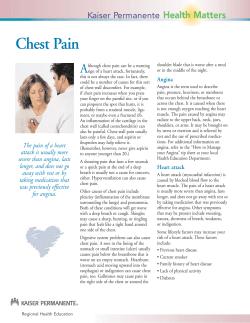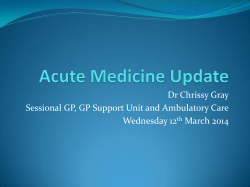
EMPYEMA
EMPYEMA Grand Rounds Monday, August 27th 2007 Michael J. Weyant, MD Assistant Professor of Surgery Section of General Thoracic Surgery University of Colorado at Denver and Health Sciences Center Empyema • Background • Diagnosis • History of treatment • Issues in modern treatment • Cases Background • 65,000 pts per year in the US • 20% Mortality • 15-20% of patients will require surgical treatment • Median hospital duration is 15 days Molnar TF et al Eur J Cardiothor Surg 2007 Definition “ The inflammatory process in a preformed anatomical space defined by the visceral and parietal pleura” Molnar TF et al Eur J Cardiothor Surg 2007 Diagnosis • History & Physical • Radiological • Pleural fluid analysis Physical Characteristics • Shortness of Breath >80% • Cough >70% • Fever >80% • Chest pain >60% Empyema - Radiographic Characteristics Empyema-Radiographic Characteristics Waite RJ et al Radiology. 1990 Apr;175(1):145-50. Empyema Necessitans Diagnosis- Pleural Fluid Analysis -Frank pus -Gram stain( direct) -Culture (indirect) pH<7.2, Glucose<400mg/l, LDH >1000 IU/ml, Total protein>3g/ml, WBC >15,000 cells/mm3 Light RW Chest. 1995 Aug;108(2):299-301 Etiology • Parapneumonic 40-60% • Post surgical 20-30% – Lung resection – Esophagectomy, – Mediastinal procedures • Post traumatic 5-10% Chapman SJ, Davies RJ Respirology. 2004;9:4-11. Empyema-Pathophysiology Stage I -Increased permeability of inflamed pleural surfaces Stage II -Fibrinopurulent stage Stage III -Organizing phase -Collagen deposition -Pleural fluid clear but high WBC’s -Entrapment of lung -Pleural fluid- Sterile -Uncomplicated parapneumonic effusion -Begin to see chemistry changes in pH, protein -Bacterial presence more likely -Effusion grossly purulent Empyema- Pathophysiology Treatment ubi pus evacua - “if you find pus remove it” Treatment • Complete evacuation of the content of infected space • Elimination of cavity • Control of causative organisms/sterilisation • Forced auxiliary treatment such as aggressive physiotherapy, • Nutritional support in every phase of treatment. Chapman SJ, Davies RJ Respirology. 2004;9:4-11. Empyema Treatment- History 229BC-Hippocrates Limited rib resection 1843-Trousseau Thoracentesis 1879-Estlander Thoracoplasty 1893-Fowler Decortication 1927-Alexander Extrapleural paravertebral thoracoplasty 1935-Eloesser Eloesser flap 1945-Tillet Fibrinolytics 1963-Clagett open drainage and irrigation 1983-Miller Complete flap closure without open drainage Open Window Thoracostomy Claggett Procedure • Dressing changes to clean cavity • Instill 0.25% neomycin • Closure of skin Open Window Thoracostomy Eloesser Flap • Tongue of skin created to prevent closure • Window created at most dependent portion of empyema Open Window Thoracostomy Current Indications • Chronic empyema • Used in transition to a more radical procedure • Debilitated patient • Expectation of long term drainage • Postpneumonectomy empyema Thoracoplasty Thoracoplasty Plumbage Thoracoplasty Plumbage Thoracoplasty Thoracoplasty- Current Indications • Infected spaces after pulmonary resection • Apical spaces after lobectomy • Empyema after pneumonectomy • Unresolved chronic empyema unrelated to pulmonary resection • Postuberculous apical empyema Decortication Decortication Muscle Flap Interposition Post Lung Resection Empyema • Post Lobectomy0.01%-2.00% • Post-pneumonectomy 2-16% • Residual space and air leak Vallieres e et al Chest Surg Clin N Am 2002:571-585 Post Lung Resection Empyema • Muscle flap closure • Limited Thoracoplasty • Open window thoracostomy Summary of Treatment Modalities • Antibiotics • Tube Drainage( thoracentesis or tube thoracostomy) • Intrapleural fibrinolytics • VATS drainage • Open thoracotomy • Chronic open drainage/Thoracoplasty Treatment Dilemmas • To lyse or not to lyse? • Surgical vs. Nonsurgical • VATS vs. open decortication • Duration of antibiotic therapy? Fibrinolytics and Empyema • First used in 1945 • Streptokinase is the most widely studied • Principle of therapy is to lyse fibrinous septations and allow improved drainage of pleural fluid Video thorascopic view of intrapleural fibrinous septations • Randomized Double blinded trial performed in 52 Centers • All pts underwent tube drainage of parapneumonic effusion and were randomized to placebo or 250,000 IU streptokinase administered through tube • Primary endpoints- requirement of further surgery or death MIST1 Trial 454 Patients eligible and provided consent 226 Randomly assigned to streptokinase 20 Patients excluded 18 Did not receive study drug (died,underwent surgery, or withdrew consent) 2 Lost to followup 228 Randomly assigned to placebo 7 Patients excluded 6 Received no trial drug (died, underwent surgery, or withdrew consent) 1 Lost to followup 206 Patients completed trial 206 Patients completed trial Results • NO reduction in the need for surgical intervention with streptokinase administration • NO reduction in mortality at either 3 or 12 months • NO reduction in hospital stay Surgical vs. Non Surgical Therapy A Randomized Trial of EmpyemaTherapy* Wait MA et al Chest. 1997 Jun;111(6):1548-51 • 20 pts with complicated emyema thoracis randomized to either chest tube + fibrinolytics vs. VATS alone • VATS had significantly higher treatment success (91%vs. 44% p<0.05) • VATS had shorter duration of chest tube drainage (5.8 vs. 9.8 days p=0.03) • Shorter hospital stay (8.7 vs 12.8 days p<0.001) • Average cost VATS $16,642 vs CT $24,052 VATS • No randomized trials • Large series report 80-85% success with VATS • Success of VATS depends on interval of preoperative symptoms Luh SP et al Chest. 2005 Apr;127(4):1427-32. Duration of Antibiotic Therapy ? Microbiological Aspects • A lack of detectable causative organisms reported between 47% and 56% • 5-10% of parapneumonic effusions become empyema • Blood cultures positive in only 10% of patients Organism of Etiology Community acquired Hospital-acquired • Streptococcus pneumoniae • Staphylococcus aureus • Haemophilus influenzae • Gram negative organisms • Staphylococcus aureus * Pleural bacteriology differs from pneumonia bacteriology * >50% of organisms are resistant to penicillins >70% of staph aureus species are penicillin resistant Survival According to Type of Infection Algorithm for Management of Parapneumonic Effusions/Empyema Diagnosis of parapneumonic effusion Therapeutic thoracentesis or tube thoracostomy Successful resolution *Unsuccessful resolution Medically stable Observation, reimaging and antibiotics VATS/Thoracotomy Drainage *Decision for surgery in 24-48hrs Medically unstable More tubes Supportive care Open window thoracostomy Fibrinolytics? Empyema Expect the Unexpected Case 1 • 65 y/ obese male presented to ER with left chest pain after episode of binge drinking • PMHX: hypertension, ETOH abuse • PSHX: Nissen fundoplication, Cholecystectomy • WBC 16,000 • CXR obtained Case 1 Case 1 Case 1 • Pleural Fluid Analysis: -pH=7.1 -glucose = 324mg/l, -LDH =1275 IU/ml, -total protein=4.3g/ml, -WBC >30,000 cells/mm3 • CT report: Empyema with lower lobe atelectasis suggesting trapped lung Case 1 Chest tube drainage and repeat CT Intrapleural fibrinolytics and repeat CT No change in loculated pleural effusion CT surgery Consult To OR for Decortication Case 1 Intraoperative Findings • Fibrinous peel overlying lung • Undigested food • Perforation in apex of prior nissen fundoplication Case 2 • 44 y/o male presented with cough, fever • PSHX: underwent right pneumonectomy 21 years prior to treat TB Case 2 • VATS exploration identified a retained 21 year-old surgical sponge • “Gossypiboma” removed surgically Case 3 • 26 y/o male presented with cough, fever, chills • PMHX: several episodes of pneumonia • CXR: opacification of right chest • Chest tube placed • CT scan performed Case 3 CT Report: Impression: 1) Right basilar empyema with lower lobe atelectasis 2) Middle lobe atelectasis Case 3- Operative Course • Bronchoscopy- complete obstruction of bronchus distal to right upper lobe takeoff • Right middle and lower bilobectomy Pathology: 1)Chronic inflammation and atelectasis of middle and lower lobes 2)Foreign body causing obstruction of bronchus ALWAYS PERFORM BRONCHOSCOPY !!!! Conclusions • Basics of treatment for >2,000 years has been drainage of infected fluid, obliteration of space • Unclear role of fibrinolytics • Be prepared for unusual sources of pleural space infection
© Copyright 2025
















